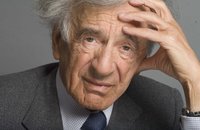
Elie Wiesel (September 30, 1928-July 2, 2016)
Tzvi H. Schoenberg, A.M. Student, Divinity, and Anne K. Knafl, Bibliographer for Religion and Philosophy
“How does one describe the indescribable? How does one use restraint in recreating the fall of mankind and the eclipse of the gods? And then, how can one be sure that the words, once uttered, will not betray, distort the message they bear?” (Elie Wiesel, “An Interview Unlike Any Other,” in A Jew Today, trans. Marion Wiesel [New York: Vintage, 1979], 15.)
Reflections on the Holocaust take various forms. In the first decades after the end of World War II, many survivors chose to publish first-hand accounts of their experience. Elie Wiesel’s internationally acclaimed memoir was originally published in Yiddish in 1956 under the title Un di velt hot geshvign (And the world kept silent). He later translated an abbreviated account into French, La Nuit, which served as the basis for his English translation, Night, published in 1960. It was this version of his experiences that catapulted him to international notoriety, including receiving the Nobel Prize for Peace in 1986.
Wiesel’s attempt to reflect on death, suffering and fate through artistic representation, was part of a larger endeavor to represent the Holocaust that invoked severe polemics among artists. Such polemics are addressed in this exhibit through the work of four influential figures: Sylvia Plath (Poetry), George Steiner (Literature), Arthur Miller (Theater), and Arnold Schoenberg (Music).
Special
attention is paid to attempts to confront both personal and collective
experiences pertaining to the Holocaust and the critical reception of such
attempts. But the exhibit also examines the way in which critical reception
prompted alternative forms of representation. Such was the case of George Steiner
who, objecting to Plath’s “personification of the Holocaust,” attempted a
non-personal representation of the Holocaust by rendering it philosophically
and in light of the problem of anti-Semitism; an account explicated in his Portage
to San Cristobal of A.H (1982). In another instance, The Diary of Anne
Frank, adopted by F. Goodrich and A. Hackett for a Broadway stage
production in 1955, was criticized severely by the playwright Arthur Miller, who
accused its creators of seeking audience gratification versus critical
reflection.
Visitors unaffiliated with the University of Chicago should contact Anne K. Knafl, aknafl@uchicago.edu, in advance of visiting the exhibit.